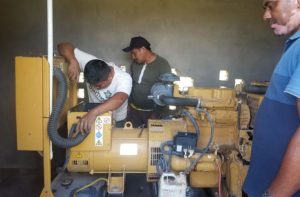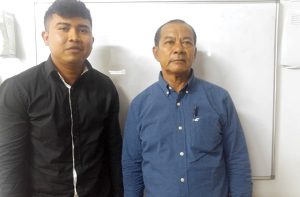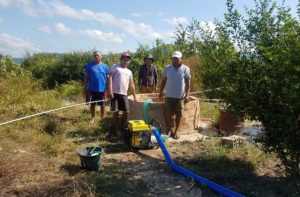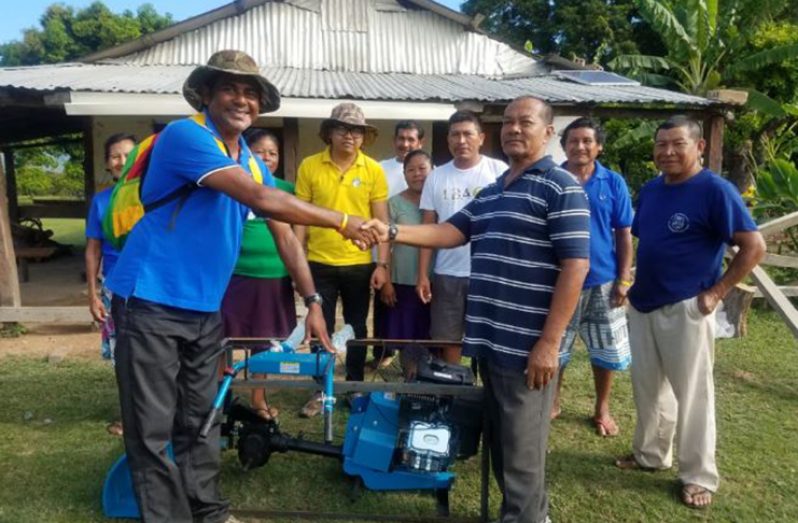THE village of Karasabai, South Pakaraimas, Region Nine (Upper Takutu-Upper Essequibo), has begun to benefit in the areas of infrastructure, electricity and agriculture, thanks to the help of two of its main representatives.
Last May, village representative Marlon Edwards and Project Coordinator Ronald Lee-Bing visited the Guyana Chronicle, to tell of several problems plaguing their community.
At the time, they were also in engagements with the ministers of government and were hopeful that the situations highlighted would receive adequate attention. On Tuesday, the men were elated to report that since their last interview, much has changed in the community and for the better.

Significant water challenges in the area will soon come to an end following fruitful engagement with the Guyana Water Inc. (GWI) at the recent National Toshaos Council (NTC) conference
Some two weeks ago, a GWI team visited the area to assess the unbalanced water distribution system in the community, which Edwards said has the most wells in Region Nine.
There are also several water tanks on trestles in satellite villages around Karasabai, which were not completed by the previous administration and the two believe this will give the GWI an edge in completing its work.
“It will not be expensive to do the work because it is 80 per cent complete. All we need is [a] pump to get the water from the wells to the trestles,” Edwards said, adding: “Before December 2018, we’re supposed to have [a] proper water system and most of the villagers will benefit from this.”
The men also met with Prime Minister Moses Nagamootoo and former Minister of Public Health, Dr George Norton, to discuss the shortage of medicine and medical supplies in their community.
VERY HAPPY

“We are so happy because a truckload of medication was sent in from Georgetown straight to Karasabai two weeks ago,” Edwards updated.
In addition, to assist the Hinterland Electrification Programme in their community, the men were able get their friends in Brazil to repair a caterpillar generator which had been non-functioning for the past four years.
They now intend to use the equipment to power households with teachers, health workers and other residents willing to contribute a small fee for its upkeep.
Also in connection with electricity, street lights are on the agenda. Edwards and Lee-Bing now intends to lobby the Public Infrastructure Ministry for the provision of street lamps and cables to brighten up their main roads.
The men are working to repair a Caterpillar Backhoe in the village, with help from their Brazilian friends, to work on the community’s internal roads which are currently just tracks through the bushes.
Meanwhile, regarding agriculture, black eye, red bean and casareep production have all begun. However, the village is now facing a lack of export markets when it comes to farine, a by-product of cassava; the village previously sold farine to neighbouring Brazil for favourable prices.
“Recently we found that the Brazilian dollar is low, so the price they [farmers] used to get for it, they’re not getting that price. So you find now that most of the farmers have left the farine in Karasabai, but there is no market for it because they are not willing to sell it for that type of price,” Lee-Bing explained.
AWAITING MARKETS
 He added that the farine awaiting markets amounts to tonnes. Now, the men are encouraging the farmers to look into peanut production as an option, as the soil in the region is suitable for the crop. Lee-Bing noted that there is also a demand for peanuts in Georgetown which is currently being met by overseas markets.
He added that the farine awaiting markets amounts to tonnes. Now, the men are encouraging the farmers to look into peanut production as an option, as the soil in the region is suitable for the crop. Lee-Bing noted that there is also a demand for peanuts in Georgetown which is currently being met by overseas markets.
The men were also able to acquire three water pumps and a soil-tiller from Food For The Poor (Guyana), which they handed over to farmers to assist with the seasonal peanut crop.
However, the farm is now in need of barbed wires to fence the land and Edwards intends to approach the Small Business Bureau (SBB) with a proposal for assistance.
Along with this, the men are also looking to receive a grant to purchase equipment, which will assist them in clay-block production.
“The people there that are making clay blocks do it manually, which means it’s a very hard and tedious task to do… there are machines in Brazil which the Brazilians use and an average Guyanese crew can make up to 700 to 800 clay blocks per day, but with a machine you can make 15,000 to 20,000 blocks per day,” Lee-Bing said.
Edwards and Lee-Bing care dearly about the opportunities for their village, because without them, it would mean that the people in their area– especially the youths — will have limited job opportunities.
Stemming from the ongoing developments, some in the community will be able to be employed as machine operators or maintenance personnel, while some hopefully will be trained by GWI and the Public Infrastructure Ministry.
“We will need persons to be trained to operate the Backhoe and the Caterpillar generator, so we will have employment opportunities for more young people in the village,” Edwards said.
Lee-Bing then added: “Our emphasis is that once you touch a machine, you must be trained to operate it and that has been lacking in most of the villages where you give them these equipment and they are not trained… so when they’re damaged, nobody knows how to check or fix it so they put it aside.”



.jpg)








